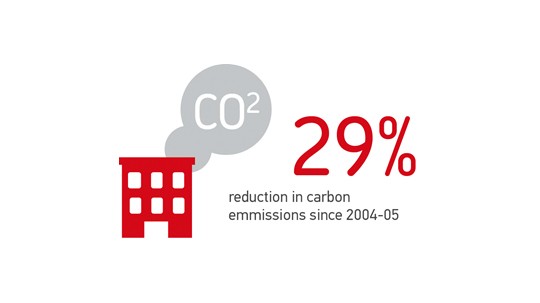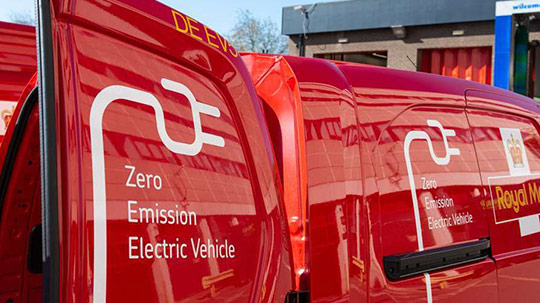Electric Vehicles: turning an iconic red fleet green
Royal Mail’s iconic red trucks and vans are as familiar a sight on Britain’s roads as the famous post boxes. This is hardly surprising since we operate 41,500 vans and 6,200 trucks and trailers.
We’ve now deployed electric trucks and vans all across the country as we continue to look at new and innovative ways to reduce our carbon footprint. The trucks and vans are also important in ensuring we’re on the front foot for changes to emission limits in many cities.
We’re committed to making changes to our operations that reduce our environmental impact, while ensuring we meet customer expectations. We’ve already met our business target of reducing our carbon emissions in the UK by 20 per cent by 2010-21. And in 2017-18, using telemetry saved us approximately 500,000 litres of diesel, equating to 1,300 tonnes of CO2e.

We’re already using around 100 electric delivery vans. These are delivering parcels, letters and cards to the doors of our customers from 18 delivery offices around the UK, including Belfast, Cardiff, Edinburgh, Nottingham and London.
There are typically six vehicles in one depot, supported by a comprehensive roll-out of charging stations installed in all 18 sites. Our engineers are now capturing robust data on mileage, costs and driver experience.
Paul Gatti, Royal Mail Fleet managing direct is delighted to be using electric vehicles in different shapes and sizes.
“Our research has shown that electric vans are a good operational fit with our business and we were delighted to have such a large volume in our daily delivery operations. It’s good news for our customers and the towns and cities which we serve. It also means we are on the front foot for future changes in emissions legislation."

“Emissions are an important issue for us at Royal Mail. We are continuously looking at new and innovative ways to reduce our carbon footprint. Improving the efficiency of our fleet by introducing electric vans is just one example.”
“Our electric vehicle fleet will grow over time and our vehicle technicians will get valuable experience of servicing them. We have invested in a comprehensive training workshop for technicians and we’ve revised some workshop processes. It’s necessary, for example, to isolate the high-voltage electrics first before doing any other repairs.”
Smaller electric vehicles are not the only electric vehicles being used by Royal Mail. We are also using some electric trucks in London, from our Mount Pleasant Mail Centre, to move mail between our larger sites in and around the capital.
"Our electric fleet will grow over time"
- Paul Gatti, Royal Mail Fleet Director
The co-branded red Royal Mail electric vehicles are the first trial vehicles to be produced at Arrival’s new factory in Banbury. One key attraction of the futuristic-looking trucks is that the 6-tonne GVW Arrival vehicles can carry the same payload as 7.5 tonners and on single-wheeled rear axles. The Arrival trucks are a modular build design, giving us the potential for greater operational flexibility.
Paul Gatti said.” We are pleased to be the first fleet operator to take delivery of and trial these new larger payload vehicles which complement the 100 electric vans. We have been putting them through their paces over the past year to see how they cope with the mail collection demands from our larger sites.”
In day-to-day charge of the electric vehicle project is Grahame Bennett, Royal Mail’s Head of Fleet Engineering. He says: “We will be able to change configurations easily to suit varying operational needs, including extending range or improving payload.” The trucks have a 1.5-litre petrol-driven range extender to support batteries on longer routes, and if greater payload is needed, one of the batteries can be removed.
“That saves tyre costs but also spreads the load more evenly. As is the case with many multi-drop delivery operations, the risk of front axle overloading during a delivery run as goods are removed from the rear is ever present. The Arrival vehicles also have an in-cab warning light if the load on either axle approaches the maximum legal permitted.“
Developing new technology fit to deliver the postal service requires lots of testing.
Grahame added: “We have been working through any issues that arise prior to deploying more. The ones in service have already experienced both very hot and very cold climate conditions, so we have valuable experience on how that impacts reliability."
"As electric vehicles grow in numbers, more infrastructure will be needed to support charging"
- Grahame Bennett, Royal Mail Head of Fleet Engineering
"They will be operating on numerous and diverse routes to help us evaluate how best they will fit into our delivery routes. But to ensure feedback is consistent, we’re using just a handful of drivers at the moment."
“As electric vehicles grow in numbers, more infrastructure development will be needed to support charging,” he points out. “The electrics capacity from the grid in London at our Mount Pleasant depot, for example, is limited.”
“Royal Mail is trialling a variety of vehicles to see which work best for us and we are keen to share our experience with other fleet operators who may be considering introducing electric vehicles. We have trialled electric trucks before but not of this type of design. We look forward to see what additional benefits they can bring to our existing fleet.”
Royal Mail’s longer-term ambition is to move to a low-carbon fleet and ensure that we are investing in a fleet that meets future legislation.
